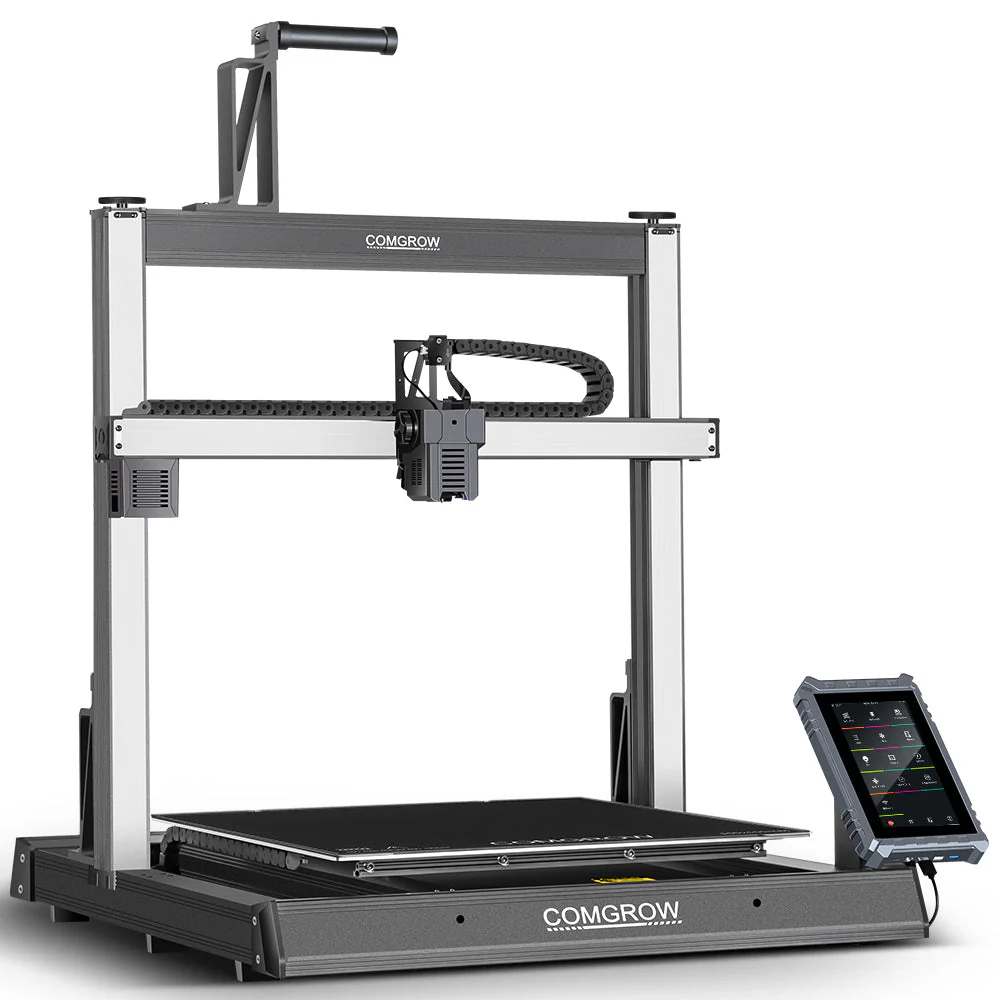Compare Ender 3 vs Comgrow T500
Comparison between the best 3D printers
Choose the best 3D printer at the best price. The cheapest 3D printers are here.
Buy a 3D printer here with 3D Fila.
 |
 |
|
| Model | Ender 3[BUY Ender 3] |
Comgrow T500 |
| Printing Material | Filament | Filament |
| Buy Filament for Creality 3D Ender 3 | Buy Filament forSovol Comgrow T500 | |
| Estimated price | $210,00 | $799,00 |
| Manufacturer | Creality 3D | Sovol |
| Release Year | 2018 | 2024 |
| Print Volume [mm] | 220x220x250 | 500x500x500 |
| Printer Size [mm] | 440x440x465 | 817x810x962 |
| Weight [kg] | 6,62 | 39 |
| Power Loss Recovery | NO | YES |
| Enclosed printer | NO | NO |
| Bed Leveling | Manual | Automatic |
| Filament End Sensor | NO | YES |
| Bed type | Heated | Heated |
| Power supply system | Bowden | Direct Drive |
| Standard nozzle | 0,4 | 0,4 |
| Maximum Nozzle Temperature [°C] | 255 | 300 |
| Maximum Bed Temperature [°C] | 110 | 80 |
| Maximum printing speed [mm/s] | 180 | 500 |
| Filament holder | YES | YES |
| Camera for supervision | NO | NO |
| Recommended filaments | PLA, TPU, ABS, PETG | PLA, PETG, Fibra de Carbono, TPU |
| Recommended slicers | Cura, Simplify, Slic3r | Creality Print, Cura 5.0 ou superior, Prusa Slicer, Orca |
| Maximum Resolution [mm] | 0,1 | 0,1 |
| Processor | 8 bits | |
| Display | Mono | 7'' IPS touchscreen, 60Hz |
| Power Supply | 24V / 270W | 500 W |
| Connectivity | SD / USB | |
| Operating systems | Windows, Mac, Linux | |
| Date of registration in the system | 2021-04-13 | 2024-07-18 |
| Release date | 2018 | 2024 |
| Extra features | The Ender 3 V1 is a DIY assembly 3D printer, a sales leader since 2017, standing out for its cost-benefit. With a wide printing capacity, it has a CNC machined structure for precision and stability. It offers high-precision prints with low noise, thanks to its innovative V-profile and pulleys. It has a self-adhesive magnetic platform for easy removal of models and excellent adhesion. The Ender 3 heats up quickly, reaching 100°C in 5 minutes, ideal for agile prints. It includes protection against power failures, allowing you to resume printing after interruptions, saving time and material. | The Sovol Comgrow T500 stands out for its large print volume of 500x500x500 mm, ideal for large-scale projects. It has a direct extruder with a gear ratio of 6.5:1, speeds of up to 200 mm/s, and high-performance motors. The 7" touchscreen with Klipper software makes navigation easy. The 49-point automatic leveling ensures a perfect first layer. It also has a full metal hotend at 300°C, linear rails on all axes, and WiFi connectivity. |
| Support for multiple colors and materials (AMS and CFS) | NO | NO |
Notes * |
||
| Cost-benefit | 6 / 10 | 7 / 10 |
| Hardware | 0.5 / 10 | 3.2 / 10 |
| Tela | . | . |
| Print volume | 3 / 10 | 5 / 10 |
| Performance | 1 / 10 | 4 / 10 |
| [BUY Ender 3] |
Conclusion |
| In comparing the Ender 3 and the Comgrow T500 3D printers, several key factors highlight their respective strengths and weaknesses, making one more suitable than the other depending on user needs and budget. The **Ender 3** is a budget-friendly printer, offering effective performance for hobbyists and beginners. Its compact printing volume is ideal for smaller projects, and its DIY assembly provides an engaging introduction to 3D printing. Despite its lack of advanced features like power loss recovery and automatic bed leveling, the Ender 3 delivers high-quality prints with a commendable cost-benefit ratio, emphasizing affordability and user accessibility. On the other hand, the **Comgrow T500** is designed for more serious enthusiasts and professionals who require a higher level of performance. With its impressive print volume, automatic leveling, direct drive system, and faster printing speeds, it caters to users who need to execute larger and more complex projects with precision. Its modern touchscreen interface and advanced features contribute to a better user experience, albeit at a significantly higher price point. In conclusion, if budget constraints are a primary concern, the Ender 3 remains an excellent choice for beginners or those looking to explore 3D printing without a large financial commitment. However, for users seeking advanced capabilities and larger build sizes, the Comgrow T500 presents a compelling option that justifies its higher price with enhanced functionality and features. The decision ultimately hinges on the user's specific requirements and whether they prioritize cost or performance in their 3D printing endeavors. |

